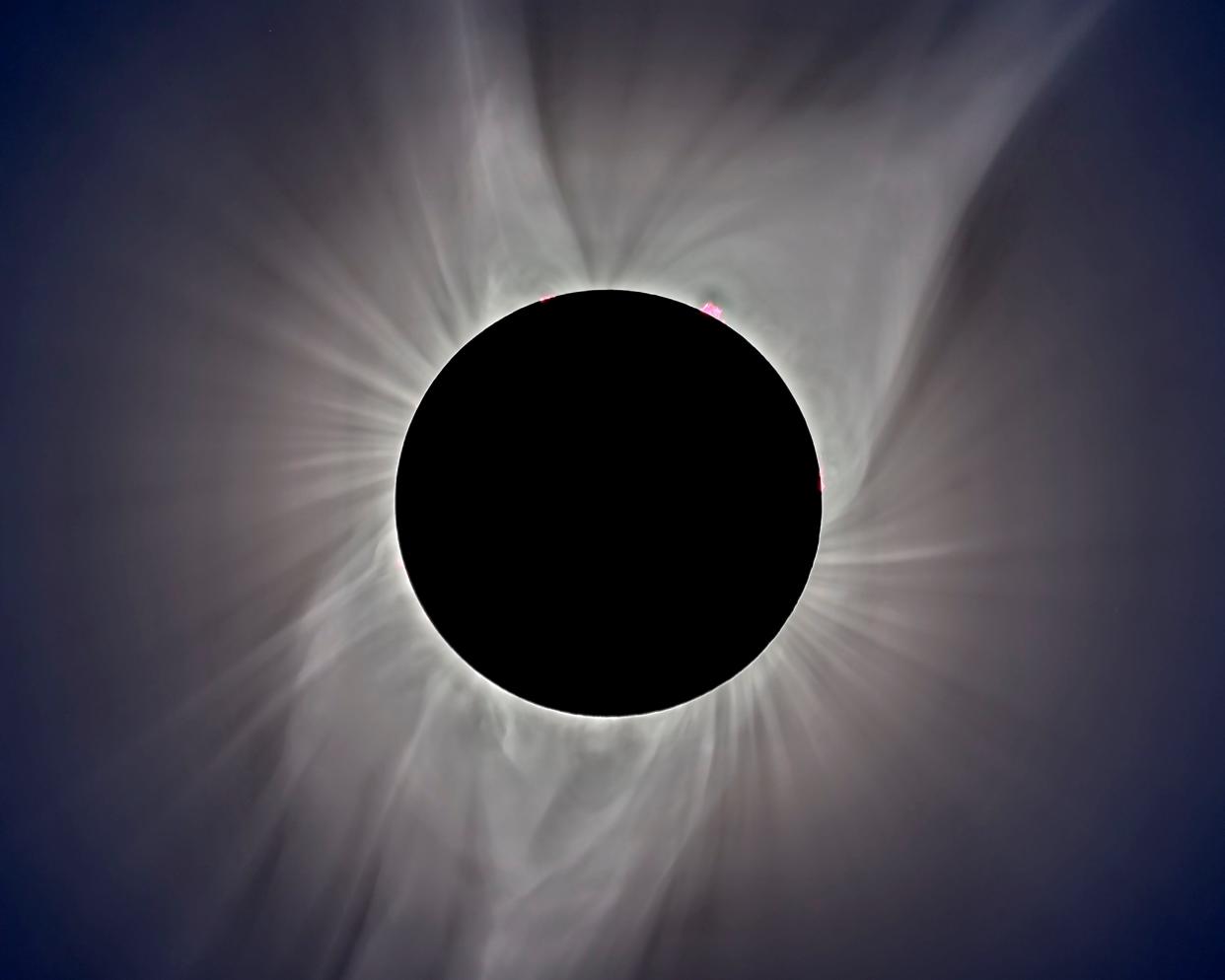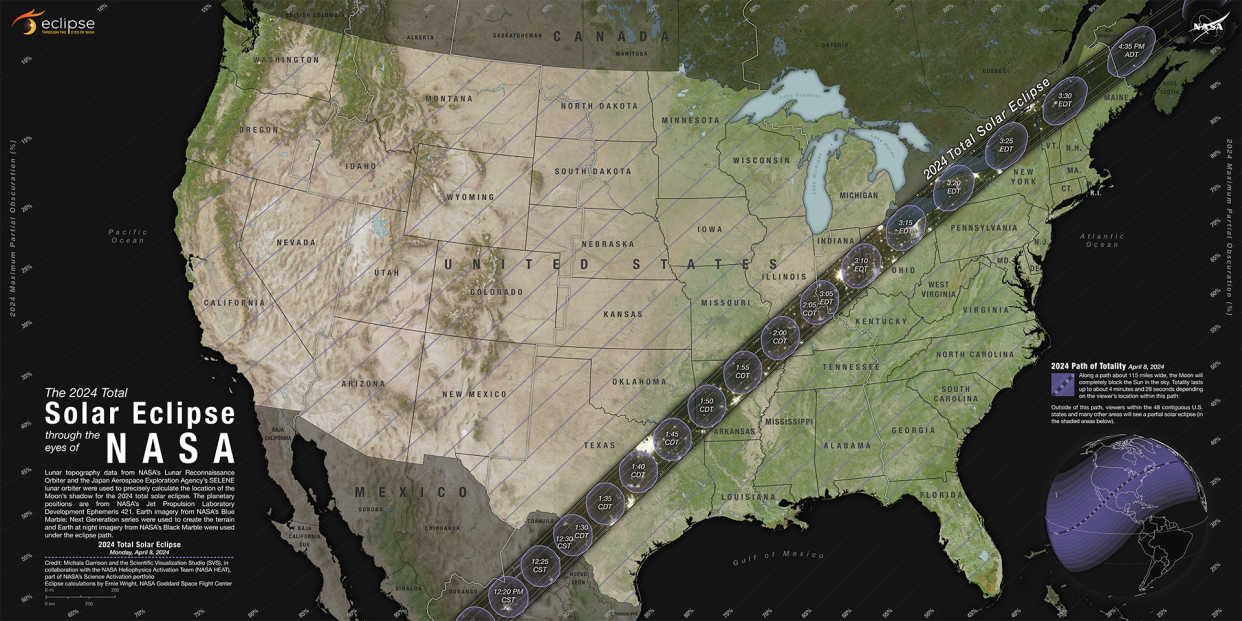Total solar eclipse will cross 13 U.S. states on April 8: Is Maryland in its path?
On April 8, 2024, Earth will be cloaked in darkness.
This natural celestial phenomenon, truly a sight to behold, is known as a total solar eclipse.
Come spring, a total solar eclipse lasting just over four minutes will cross North America, passing directly over Mexico, much of the United States and Canada.
Here's everything you need to know about the upcoming astronomical event, such as where it can be witnessed across the U.S., its path of totality and more.
What is a total solar eclipse?
A total solar eclipse occurs when the orbiting moon passes between the sun and Earth, completely concealing the bright face of the sun. As the moon's shadow sweeps over Earth's surface, the sky will slowly darken — mirroring dawn or dusk.
DAYLIGHT SAVING TIME: When does Daylight Saving Time begin? Here's when to 'spring forward' in 2024
What is the eclipse's path of totality?

To witness the total solar eclipse, onlookers will need to be within the path of totality, which will stretch 115 miles wide.
Weather permitting, the first location in continental North America that will experience totality is Mexico’s Pacific coast at around 11:07 a.m. PDT. The eclipse will exit continental North America on the Atlantic coast of Newfoundland, Canada, at 5:16 p.m. NDT, reported NASA.
The path of the eclipse will enter the U.S. in Texas, before cutting diagonally across the country.
The eclipse will then travel through Oklahoma, Arkansas, Missouri, Illinois, Kentucky, Indiana, Ohio, Pennsylvania, New York, Vermont, New Hampshire and Maine. Small parts of Tennessee and Michigan will also experience the total solar eclipse, according to NASA's map.

SOLAR ECLIPSE INTERACTIVE MAPS: How long will the solar eclipse darkness last in your city? Explore these interactive maps.
Here are the 13 major U.S. cities that will experience totality on April 8 (note that the included times do not account for when the partial eclipse begins and ends), reported USA TODAY:
Dallas, Texas: 1:40-1:44 p.m. CDT
Idabel, Oklahoma: 1:45-1:49 p.m. CDT
Little Rock, Arkansas: 1:51-1:54 p.m. CDT
Poplar Bluff, Missouri: 1:56-2:00 p.m. CDT
Paducah, Kentucky: 2-2:02 p.m. CDT
Carbondale, Illinois: 1:59-2:03 p.m. CDT
Evansville, Indiana: 2:02-2:05 p.m. CDT
Cleveland, Ohio: 3:13-3:17 p.m. EDT
Erie, Pennsylvania: 3:16-3:20 p.m. EDT
Buffalo, New York: 3:18-3:22 p.m. EDT
Burlington, Vermont: 3:26-3:29 p.m. EDT
Lancaster, New Hampshire: 3:27-3:30 p.m. EDT
Caribou, Maine: 3:32-3:34 p.m. EDT
What is totality for a solar eclipse?
A solar eclipse's path of totality is where observers located in the center of the moon's shadow will see the moon completely cover the sun. Totality is the only stage of the eclipse that can viewed with the naked eye, according to NASA.
Due to the sun's bright surface, special eclipse glasses must be worn for safety during every other stage.
When a solar eclipse reaches totality, wildlife may display confusion and altered activity patterns. For example, nocturnal animals may begin to wake up, while non-nocturnal animals may confuse the short period of darkness for bedtime.
Latest business news: Dough Roller closes Ocean City location, new Salisbury candy store | What's Going There
Are total solar eclipses considered rare?
On average, total solar eclipses occur approximately once every 18 months.
Yet, the phenomenon is still considered a rarity, for it is not always visible from a specific location on Earth. The next time the path of a total solar eclipse will cross over the U.S. from coast to coast will be on Aug. 23, 2044, according to NASA.
2024 TOTAL SOLAR ECLIPSE: What does a total solar eclipse look like? Photos from past events show what to expect in 2024
Can I see the total solar eclipse in Maryland?
The state of Maryland is not in the solar eclipse's path of totality.
However, a partial eclipse — hinging on good weather and clear skies — will be visible throughout all 48 contiguous U.S. states, including Maryland.
A partial eclipse occurs when the orbiting moon passes between the sun and Earth, but the sun, moon and Earth are not perfectly lined up.
Marylanders who want to travel to witness the big event won't have to go too far. The total solar eclipse will be visible in nearby cities such as Erie, Pennsylvania; Cleveland, Ohio; and Buffalo, New York.
MARYLAND-MADE MOVIES: Sleepless in Seattle... in Baltimore? Eight great romantic comedies filmed in Maryland
Olivia Minzola covers communities on the Lower Shore. Contact her with tips and story ideas at ominzola@delmarvanow.com.
This article originally appeared on Salisbury Daily Times: Where and how to witness the total solar eclipse coming soon across US
